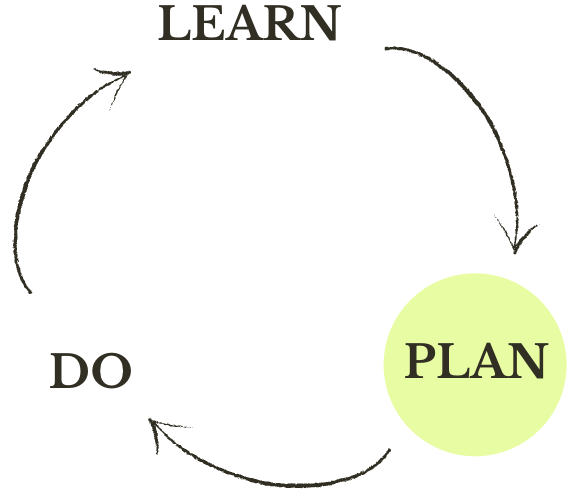PLAN
YOUR GOALS
As you steward the land, it’s important to define the goals that drive your work. People have different values and intentions, and only you can articulate yours. Writing it down keeps you on track and creates clarity for other people you are working with..
Below is a sample list of land stewardship goals. The colored icons appear on each vegetation management practice that helps achieve that goal.














Knowing more about how land works can inform your expectations and goals. See this primer on Ecological Principles.
What combination of these land stewardship goals is most important to you?

Reduce the risk of wildfire damage to people, infrastructure, and plants and animals.
Get guidance on fire-related risks and opportunities of a particular parcel using the Wildfire Fuel Mapper. To understand your context in the wider fire-risk landscape, explore the Wildfire Resilience Planner.

Enhance habitat, foster wildlife, increase the numbers and variety of native plants, animals, and ecosystem processes.
A great tool for seeing how a particular parcel contributes to biodiversity, habitat connectivity, watersheds, and climate resilience is the Explorer Tool of the Conservation Lands Network. Learn whether particular species are likely to occur on the land by looking up where other people have observed them in iNaturalist.

Increase water quality and quantity, infiltrate water into the ground, reduce stream temperatures, increase the duration of streamflow

Improve or maintain views and scenic enjoyment

Carbon sequestration and storage, capturing and retaining carbon in the ground or in long-lived plants. More here

Drought resilience, flood readiness, climate adaptation, “nature-based solutions,” process-based restoration

How workers are paid, represented, trained, respected, and protected from injury, heat, and other work-related dangers

Enrich and retain soils

Greater knowledge about and connection with the land (eco-literacy) for the site’s residents, stewards, the public, or other visitors

Supporting Tribal sovereignty; providing access to land for cultural uses such as ceremonies or gathering, and education; consulting Tribal, Native, and/or Indigenous people to guide stewardship

Maintain or create trails, road infrastructure, camping spots, or other private or public use

Life, family, and legacy goals such as inheritance or historical uses of land

Making money from harvesting timber, firewood, mushrooms, or floral resources; land appreciation; event rentals; and more
Or other goals you may have
If you’re not sure, ask yourself these questions:
- What do you value about this piece of land?
- What are the most important services this land provides to you? What services does it provide to the surrounding area (the neighborhood, region, wildlife, plants, as well as people)?
- What animals or plants live here that you treasure? Which ones would you like to see less of or more of?
- What are the top three to five outcomes you’d like to see? These can be changes, or they can be keeping things that are already present.
- Do any of your intended outcomes seem to conflict?
- What information or expertise do you need to turn your goals into an action plan?
More about carbon… Plants are mostly carbon, so thinning affects carbon storage and sequestration. Learn about these dynamics here. Globally, this matters enormously, because excess carbon and other gasses in our atmosphere are cooking our planet. But it’s complicated. Given the current state of science, this guide is unable to say whether particular land stewardship practices have a net positive impact on carbon sequestration and storage. The net impact on the atmosphere of land stewardship activities is affected by the loss of cut material, disposition of cut material, subsequent growth of retained trees, decomposition rate of cut material, reduced risk of wildfire, and emissions from beneficial fires. However, there are ways to keep the carbon that you cut onsite for as long as possible; i.e. to sequester and then store that carbon. See habitat piles, gully stuffing, and lop and lay.

